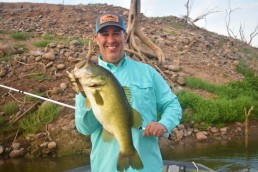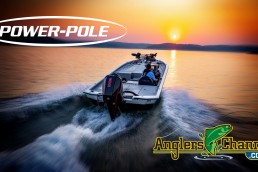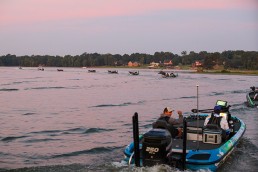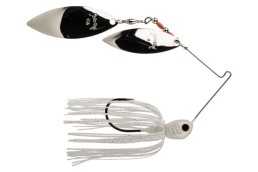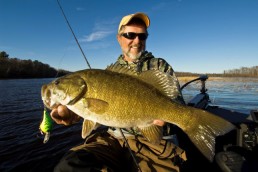Low Water Strategies for Lake El Salto
By Pete Robbins – Half Past First Cast
As I’ve written before, Hanna and I love fishing Mexico’s Lake El Salto in May and June, when the water level is typically at its lowest, The bass get schooled up on offshore structure and both the numbers and average size can be mind-blowing. In fact, of the nearly 20 trips we’ve taken to Angler Inn’s flagship location, by far our best was May/June of 2013, when the water was the lowest we’ve seen it before or since. Low water is no guarantee of superior fishing, but the great trips this time of year clearly outweigh the merely good ones.
Of course, you’ll want to “make hay while the sun shines.” When fishing is good, squeeze every drop of excellence out of the opportunity because you never know when the next great trip will present itself. Here are strategies I’ve developed that I feel give me a leg up:
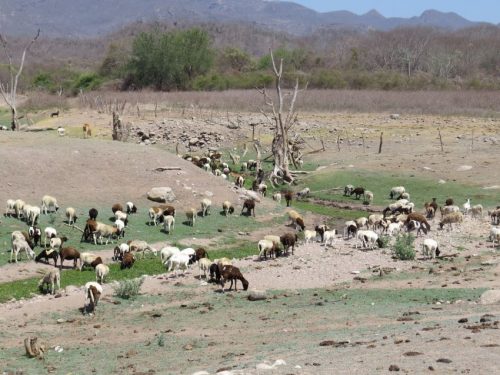
Start Early
Low water means that the lake will fish small – its acreage is dramatically decreased versus the fall and early winter when the water is up. With boats buzzing around, it means that the comparatively few shallow fish can be somewhat spooky. When we’ve had topwater success under these conditions, there has typically been a very brief window at first light to get the job done. Try to be one of the first boats out, or at least the first to fish a general area. In July there may be more hours of overcast, but from April to June there’s rarely a cloud
in the sky, so get up and get going. That bite can be great, but it often fizzles in a hurry.
Follow Shade
If you want to extend the shallow water bite, steer clear of areas that are exposed to early sunlight. In my experience those are the zones that will change most quickly. Follow thick tree lines or – better yet – bluff walls. Fish will stay on the bluffs all day, feeding at various depth zones, and depending on which way they face they may delay the early sunlight.
Stay Late
One of the reasons that it remains comfortable to fish in Sinaloa in the hotter months is because a stiff breeze shows up every afternoon. I can’t prove it, but I’m convinced that it creates currents that position the fish. However, I can tell you that at least anecdotally the worst bite is often right before lunch and right after siesta. I speculate that it’s because the fish haven’t had time to fully adjust to the currents. The bite typically gets better as the afternoon progresses and the topwater bite can fire up again right before dark.
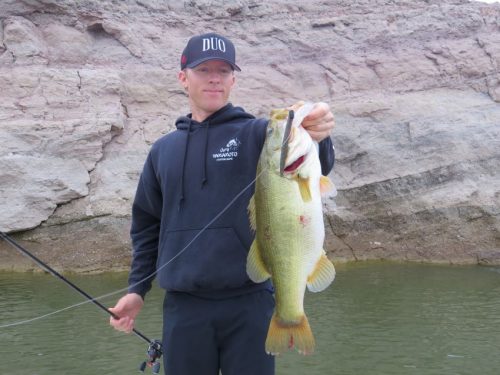
Take the Siesta
During our winter trips, when you come in around 11am and head back out around 1:30, I rarely take a post-lunch siesta. The days are just too short and the hours too valuable to risk missing a minute of fishing. In May and June, though, when it gets light at 5 and stays light until nearly 8, I lie down most days to take a rest from the heat. Even with a short siesta (during the time when I feel the fishing is often slowest), I still get 12+ hours of fishing and by the end of the week I’m still fully energized.
Don’t Disrupt the School
The guides at Anglers Inn are masters of getting crankbaits, swimbaits, jigs and other lures unstuck, and no one wants to leave one on the bottom of the lake, but if you have a monstrous school of bass fired up and you get snagged in a manner that’s unlikely to get resolved favorably, sometimes it makes sense to break off rather than try to retrieve it. First of all, if the school if active and you waste 10 minutes with a plug knocker, you risk missing that flurry of activity. Second, if you get on top of them and make a ruckus, you risk ending the activity yourself. The key to catching more schooling bass is to keep them biting.
Timing is Everything
The “hows” and “whys” of offshore bass are mysteries to most of us – they often have to do with winds and changing weather conditions and baitfish movements that we can’t see. There are certain key structural elements that produce day after day when the water is low, year after year after year. If you show up on one of them and don’t light the world on fire (or even get a bite) that doesn’t mean it won’t produce later. A few years ago we had a channel bend point that produced quality and numbers every day between 9 and 10 am. If we went there earlier, nada. Afternoon, nada. Just that one window.
Keep a Big Fish Bait Handy
You may be crushing the schooling fish on a 10XD or 10-inch worm or football jig – and clearly those lures produce giants — but again you need to keep them honest with something with even more big fish appeal. Ideally it’s something that you can throw a long way if fish come up busting a cast-and-a-half away. We had one spot in 2017 where every evening we’d get on the tree line and pick away at fish with a 1 ounce spinnerbait, but I also kept a Whopper Plopper 130 at the ready. I could fire it further back in the brush, and steer it through the sticks, and just about every evening I got a “bonus fish” of 6 to 8 pounds that way.
Tackle Prep
For much of the year at Anglers Inn you will walk from your room to the boats or take the “moving bleachers” to the water. When the lake is at its lowest, however, there’s no water in front of the camp. You’ll need to take a van across the dried out lake bed to where the boats are now positioned. It becomes a pain in the butt to take your tackle back and forth. I leave most of my stuff there every night – it’s safe and the guides will take the time to retie and reorganize everything for you. At the same time, don’t use this as an excuse to be lazy. If a
reel needs new or different line, bring it back to the lodge. If you run out of a certain bait, be sure to restock. You don’t need to bring your whole tackle bag back every night, but a few key utility boxes or binders are little inconvenience.
Take Mental Notes
If you’re going to come back at a different time of year (yes, you’ll want to come back at this time, but also at others) take note of your surroundings. Envision the lake with 10, 20 or 30 more feet of water in it. Think about likely fish-holding structure and cover. Even if you’re not sure that you’ll be able to remember how everything sets up, or the location of specific items, take note of the trees and bushes and rockpiles that are now out of the water. That will clue you into how to fish them better generally, which should pay huge dividends.
If you’d like to join us at Lake El Salto – during low water conditions, high water conditions, or somewhere in between, shoot us an email at [email protected].
